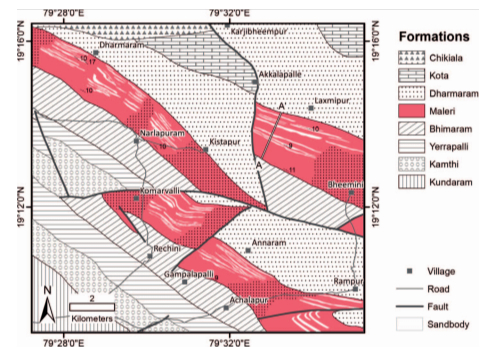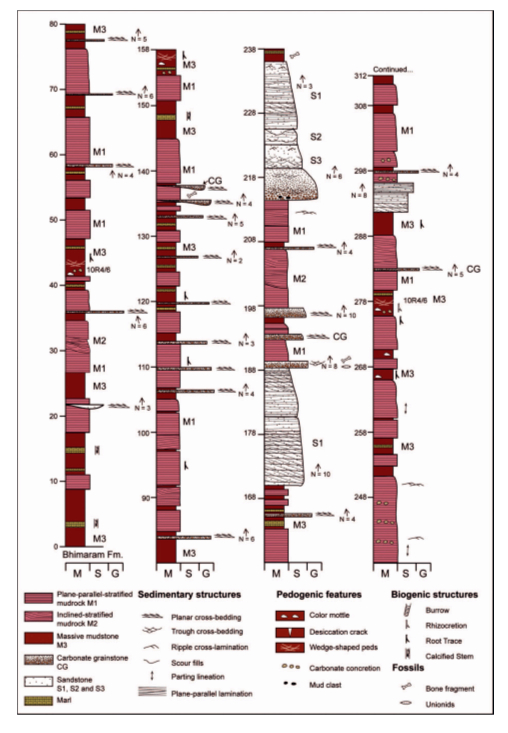Maleri Fm
Type Locality and Naming
Pranhita-Godavari Basin: Fossiliferous beds near village Maleri, first noticed by Hislop (1864) were grouped with the Kota Fm fish beds and designated as the Kota-Maleri 'Stage' by Hughes (1876). King (1881) differentiated these two formations. It is named after the village Maleri, Telangana. [Original Publication: Hughes, T.W.H. 1876. On the relations of the fossiliferous strata at Maleri and Kota, near Sironcha, Central Province. Rec. Geol. Surv. Ind., 9(3), 63-114.; King, W. 1881. The geology of the Pranhita-Godavari valley. Mem. Geol. Surv, Ind., 18(30), 150-311;].
[Figure 1: Geological map depicting exposures of the Maleri Formation in the Pranhita-Godavari valley (modified after Kutty et al. 1987; Kutty and Sengupta 1989; and Bandyopadhyay and Sengupta 2006; Dasgupta et al., 2017). Major sheet-sandstone bodies of the Maleri Formation are marked within the formation in white. The litholog presented below was measured along the line A–A'. Poorly exposed areas of the Maleri Formation are marked with stipples (adopted from Dasgupta et al., 2017)]
Lithology and Thickness
Siltstone. Maleri Formation is represented by a mudstone dominated, nearly 400-m-thick fluvial succession deposited under a semi-arid climate (Sarkar, 1988). It is divisible into a lower part (100–150 m thick) comprising vertically stacked siltstone dominated intervals, and an upper part (200–300 m thick) containing multistoried, sheet sandstone, vertically separated by comparatively thicker siltstone-dominated intervals (Dasgupta and Ghosh, 2018).
[Figure 2: Sedimentological log of the Maleri Formation along the transect A–A' marked in the geiological map. The base (0 in A) is at the contact with the underlying Bhimaram Formation, and the top (522 in B) is at the contact with the overlying Dharmaram Formation. The horizontal axis represents grain size of the sediments (M for mud, S for sand, and G for gravel) and the vertical scale is in meters (adopted from Dasgupta et al., 2017)]
Relationships and Distribution
Lower contact
Maleri Formation conformably overlies the Bhimaram Fm.
Upper contact
Maleri Formation is conformably overlain by the Dharmaram Fm.
Regional extent
Pranhita-Godavari Basin: The main outcrop extends southeast from Chirakunta beyond Maleri village to Isnai. Two more outcrops occur to the north of the main outcrop and the fourth to the south.
GeoJSON
Fossils
The Maleri Formation has two Vertebrate assemblages, which have led to a biochronological subdivision into lower (Carnian) and upper (Norian) horizons (Kutty and Sengupta 1989).
Lower Maleri fauna comprises: Fishes: Mooreodontus indicus (Jain 1980), Ptychoceratodus (Ceratodus) virapa (Oldham 1859; Martin et al., 1999), Ptychoceratodus (Ceratodus) hislopianus (Oldham 1859; Martin et al., 1999); Amphibian: Panthasaurus (Metoposaurus) maleriensis (Roy Chowdhury, 1965; Hunt, 1993; Sengupta 2002; Chakravorti and Sengupta, 2018); Reptiles; Malerisaurus robinsonae (Chatterjee, 1980), Hyperodapedon (Paradapedon) huxleyi (Lydekker, 1881; von Huene 1938; Chatterjee, 1974), Parasuchus hislopi (Lydekker, 1885; Chatterjee, 1978), cf. Angistorhinus (aff. Rutiodon) (Hungerbuhler et al., 2002), cf. Typothorax (Jain and Roy Chowdhury, 1987), Alwalkeria maleriensis (Chatterjee, 1987), cf. Massospondylus sp. (Kutty et al., 1987), Exaeretodon statisticae (Chatterjee, 1982), Deccanodon maleriensis (Nath and Yadagiri, 2007).
Upper Maleri Formation comprises: Fishes: Xenacanthus indicus (Jain 1980), Mooreodontus indicus, Arganodus (Ceratodus) nageswari (Shah and Satsangi 1969; Skrzycki et al. 2018), Polyacrodus ?Contrarius (Prasad et al., 2008), Subholostean incertae sedis. (Jain et al. 1964); Amphibians: Compsocerops cosgriffi, Kuttycephalus triangularis (Sengupta, 1995); Reptiles: Angistorhinus sp. (Rutiodon) (Hungerbuhler et al., 2002), cf. Leptosuchus (Hungerbuhler et al., 2002), Aetosauria indet. (Kutty et al. 1987; Bandyopadhyay and Sengupta, 2006), Nambalia roychowdhurii, Jaklapallisaurus asymmetrica, Guaibasauridae indet., Dinosauriformes indet., (Novas et al., 2011), cf. Ischigualastia (Edler, 2000).
Although megaflora consisting Schizoneura sp., Neocalamites sp., Caldophlebis indica, Cladophlebis sp., Glossopteris indica, G. communis, G. stricta, G. retifera, Thinfoldia hughesi, Dicroidium odontopteriodes, Noeggerathiopsis sp., Nilsonia sp., Zamites sp., Podozamites sp., Taeniopteris spatulata, Pagiophyllum sp., Elatocladus conferata, Araucarites cutchensis, Araucarioxylon, Mesembrioxylon and Tetraceoxylon (source Bose, 1966c, Rajnikanth 1994, Peter, 2009) has been reported, this assemblage comes from the combined Kota Fm – Maleri Fm ).
Age
Depositional setting
Additional Information
References
Bandyopadhyay, S., and Sengupta, D. P. 2006. Vertebrate faunal turnover during the Triassic-Jurassic transition: an Indian scenario, in Harris, J. D., Lucas, S. G., Speimann, J. A., Lockley, M. G., Milner, R. C., and Kirkland, J. I., eds., The Triassic-Jurassic Terrestrial Transition, New Mexico Museum of Natural History, v. 37, p. 77-85. Chakravorti, S.; Sengupta, D.P. (2018). Taxonomy, morphometry and morphospace of cranial bones of Panthasaurus gen. nov. maleriensis from the Late Triassic of India. Journal of Iberian Geology. doi:10.1007/s41513-018-0083-1 Chatterjee, S. 1974. A rhynchosaur from the Upper Triassic Maleri Formation of India: Philosophical Transactions of the Royal Society of London, B267, 209-261. Chatterjee, S. 1978a. A primitive parasuchid (phytosaur) reptile from the Upper Triassic Maleri Formation of India: Palaeontology, 21, 83-127. Chatterjee, S. 1980b. Malerisaurus, a new eosuchian reptile from the Late Triassic of India: Philosophical Transactions of the Royal Society of London, B291, 163-200. Chatterjee, S. 1982. A new cynodont reptile from the Triassic of India: Journal of Paleontology, 56, 203-214. Chatterjee, S. 1987. A new theropod dinosaur from India with remarks on the Gondwan-Laurasia connection in the Late Triassic, in McKenzie, G. D. ed., Gondwana Six: Stratigraphy, Sedimentology and Paleontology. Geophysical Monograph 41:Washington, D.C., American Geophysical Union, p. 787-793. Dasgupta, S., and Ghosh, P., 2018, Freshwater carbonates within a Late Triassic siliciclastic fluvial system in a Gondwana rift basin: the Maleri Formation, India. Sedimentary Geology, 373, pp. 254–271. Dasgupta, S., Ghosh, P., and Gierlowski-Kordesch, E.H., 2017, A discontinuous ephemeral stream transporting mud aggregates in continental rift basin: the Late Triassic Maleri Formation, India. Journal of Sedimentary Research, 87, 838–865. Edler, A. L. 2000. Late Triassic dicynodonts: their anatomy, relationships, and paleobiogeography. M.S Thesis: Lubbock, Texas, Texas Tech university. Hislop 1864 Hughes, T.W.H. 1876. On the relations of the fossiliferous strata at Maleri and Kota, near Jain, S.L., 1980. Freshwater xenacanthid (=Pleuracanth) shark fossils from the Upper Triassic Maleri Formation, India. Journal of Geological Society of India 21, 39–47. Sironcha, Central Province. Rec. Geol. Surv. Ind., 9(3), 63-114. Jain, S.L., Robinsion, P.L. & Roy Choudhury, T. 1964. A new vertebrate fauna from the Triassic of Deccan, India. Quarterly Journal of Geological Society of London 120, 115–124. Jain, S.L. & Roy Chowdhury, T., 1987. Fossil vertebrates from the Pranhita-Godavari valley (India) and their stratigraphic correlation. In Gondwana Six: Stratigraphy, Sedimentology and Palaeontology, G.D. Mckenzie, ed., Geophysical Monograph 41. American Geophysical Union, Washington, DC, 219–228. Hungerbühler, A., Chatterjee, S., and Kutty, T. S. 2002. New phytosaurs from the Upper Triassic of India: Journal of Vertebrate Paleontology, Abstracts, 22 (3): 68A. Hunt, A.P., 1993. Revision of the Metoposauridae (Amphibia: Temnospobdyli) and description of a new genus from Western North America. In: Morales, M., (Ed.), Aspects of Mesozoic Geology and paleontology of the Colorado Plateau, Museum of Northern Arizona Bulletin, 59: 67–97. King, W. 1881. The geology of the Pranhita-Godavari valley. Mem. Geol. Surv, Ind., 18(30), 150-311 214–19. Kutty, T. S., Jain, S. L. & Roy Chowdhury, T. 1987. Gondwana sequence of the northern Pranhita–Godavari Valley: its stratigraphyand vertebrate faunas. The Palaeobotanist 36: 214–19. Kutty, S. and Sengupta, D. P. 1989. Late Triassic formations of the Pranhita-Godavari Valley and their vertebrate faunal sequence – a reappraisal. Indian Journal of Earth Sciences, 16: 189-206. Lydekker, R. 1881. Note on some Gondwana vertebrates. Records of the Geological Survey of India 14:174-178 Lydekker, R. 1885. The Reptilia&Amphibia of the Maleria&Denwa Groups. Memoirs of the Geological Survey of India.PalaeontologiaIndica, Series IV. Indian Pretertiary Vertebrata 1(5):1-38 Martin M, Barbieri L, Cuny G. 1999. The Madagascan Mesozoic ptychoceratodontids (Dipnoi).Systematic relationships and paleobiogeographical significance. Oryctos. 2: 3–16. Nath, T.T.; Yadagiri, P.Y. (2007). A new mammal-like reptile (Cynodontia) from the Upper Triassic Maleri Formation of Pranhita-Godavari Valley, Andhra Pradesh. Journal of the Geological Society of India. 69: 57–60. Oldham T. 1859. On some fossil teeth of the genus Ceratodus from Maleri, South of Nagpur. Memoirs of the Geological Survey of India; Vol. 1, Calcutta: Geological Survey of India; p. 300–309. Novas, F. E., Ezcurra, M. D., Chatterjee, S., and Kutty, T. S. 2011. New dinosaur species from the Upper Triassic Upper Maleri and Lower Dharmaram formations of Central India. Earth and Environmental Science, Transactions of the Royal Society of Edinburgh, 101: 333-349. Peter, 2009 Prasad, G.V.R., Singh, K., Parmar, V., Goswami, A., Sudan, C.S., 2008. Hybodont shark teeth from continental Upper Triassic deposits of India. In: Arratia, G., Schultze, H.-P., Wilson, M.V.H., (Eds.), Mesozoic Fishes 4: Homology and Phylogeny. Verlag Dr. Friedrich Pfeil, Germany, pp. 413–432. Robinson 1967 Roy Chowdhury, T. 1965. A new metoposaurid amphibian from the Upper Triassic Maleri Formation of Central India. Philosophical Transactions of the Royal Society of London, Series B 250:1–52. Sarkar S., 1988. Petrology of caliche-derived peloidal cacirudite/calcarenite in the Late Triassic Maleri Formation of the Pranhita-Godavari valley, south India. Sedimentary Geology, 55, 263–282. Sengupta, D. P. 1995. Chigutisaurid temnospondyls from the Late Triassic of India and a review of the Family Chigutisauridae. Palaeontology 38(2): 313-339 Sengupta, D.P., 2002. Indian Metoposaurid Amphibians revised. Palaeontological Research 6 (1): 41–65. Sengupta, S.M., 1970, Gondwana sedimentation around Bheemaram (Bhimaram), Pranhita-Godavari Valley, India. Journal of Sedimentary Petrology, 40, 140 –170. Shah SC, Satsangi PP. 1969. A new Ceratodus species from the MaleriBeds, Andhra Pradesh. Rec Geol Surv India. 98:175–178. Skrzycki P, Niedźwiedzki G, Tałanda M. 2018. Dipnoan remains from the Lower-Middle Triassic of the Holy Cross Mountains and northeasternPoland, with remarks on dipnoan palaeobiogeography.Palaeogeogr Palaeoclimatol Palaeoecol. 496:332–345. von Huene F. 1938. Stenaulorhynchus, ein Rhynchosauridae der ostafrikanischen Obertrias. Nova Acta Leopoldina, Neue Folge, 6, 83–121.

